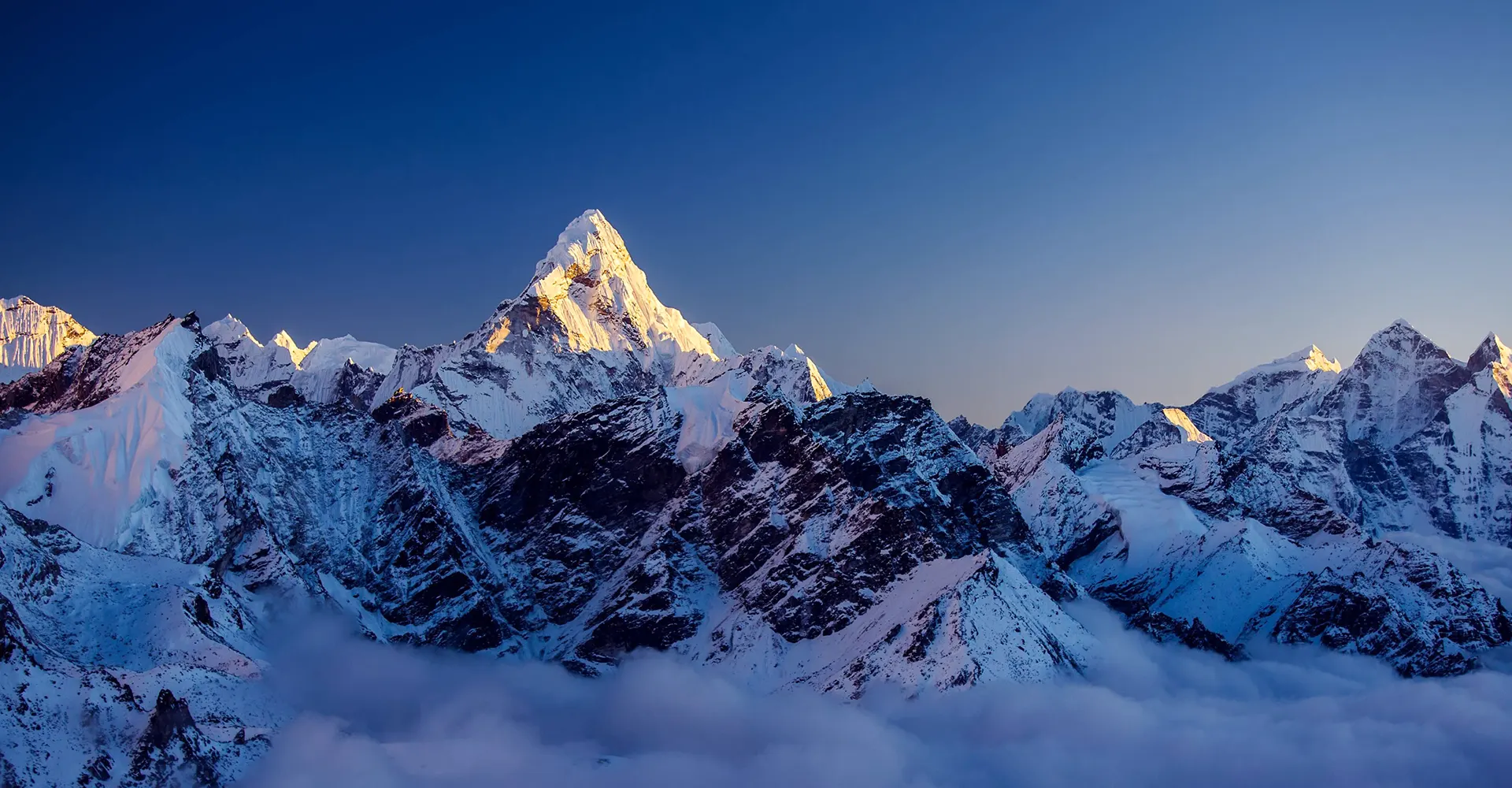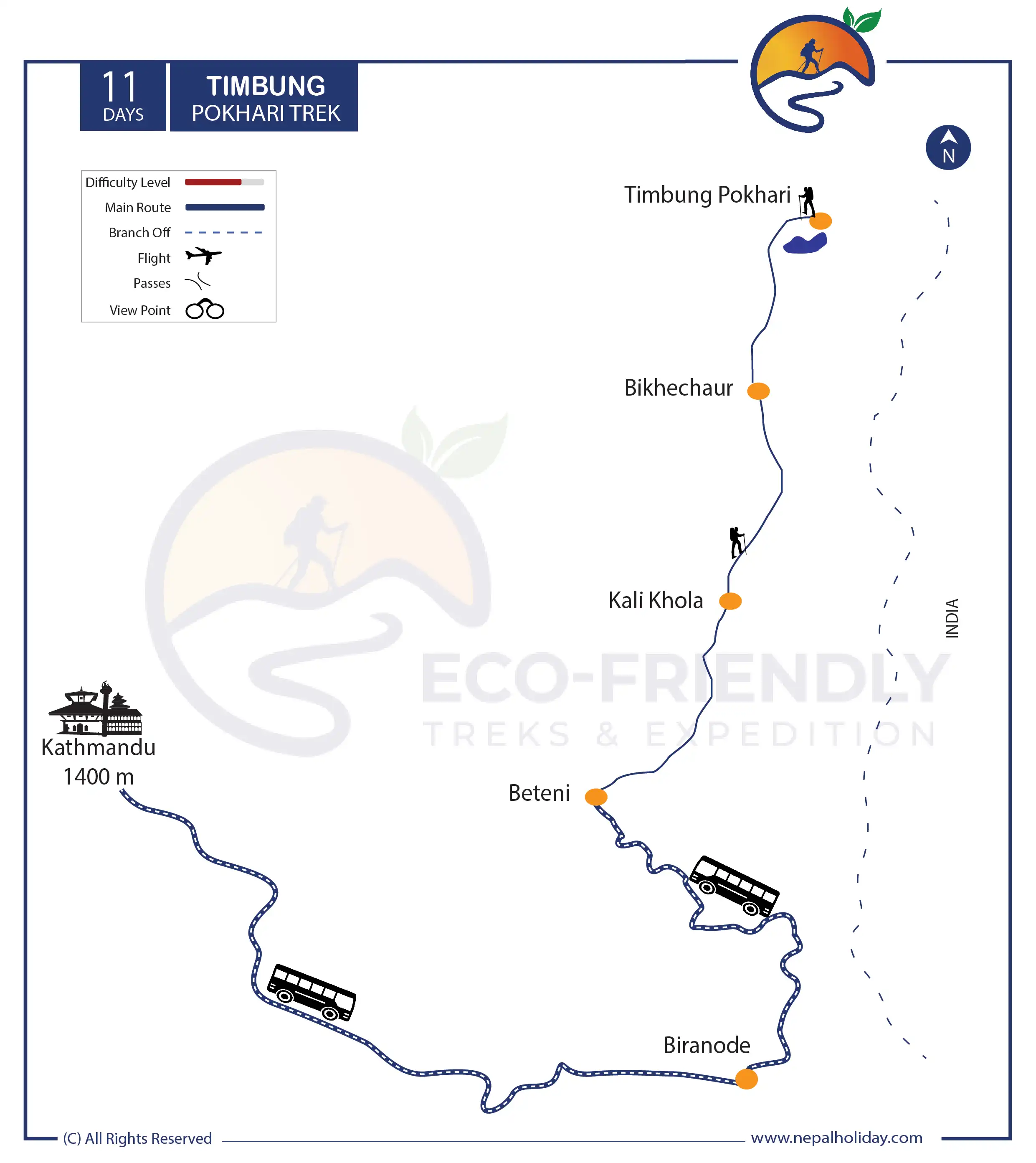Trip Introduction
Overview of Timbung Pokhari Trek
The name “Timbung Pokhari Trek” comes from the Limbu word “Timbak,” which means “gunshot.” People in the area named the pond “gunfire” because it often makes a sound like gunfire.
Timbung Pokhari is one of 100 new tourist spots added by the federal government in 2018. Its name is just as interesting as its landscape. This is the perfect hike for people who like to go on hikes that aren’t taken very often.
At 4335 meters above sea level, it is very high. It covers an area that is 466 meters long and 154 meters wide. People who are religious in the Hindu faith and people who want to get lost in the beauty of nature should go to Timbung Pokhari. People think of it as heaven on earth because it is so beautiful and quiet there.
Even though it snows over the pond for six months out of the year, thousands of pilgrims have been coming here for hundreds of years to do puja. A lot of pilgrims gather around the pond during the month of Shrawan (July–August) and during festivals like Janai Purnima and Nag Panchami.
The area around the pond is home to many rare plants and animals and is also known as the natural city. Essential herbs like Bikham, Kutki, Panchaule, Padmachal, Jatamasi, and Yarsagumba grow in this field. Aromatic herbs like Sunpati, Bhairungpani, and Sikpale are also there.
The Himalayan monal, the Himalayan blue sheep, the Himalayan goral, the bear, the snow leopard, the musk deer, the red panda, and many other animals live in the area. Join us on this trek to see one of Nepal’s hidden gems that has not been opened up to tourists yet.
Itinerary of Timbung Pokhari Trek
Includes/Excludes
What's Included?
- A guide to managing the entire holiday.
- Basic yet comfortable accommodation on a twin-sharing basis during the trekking as per itinerary.
- Breakfast, lunch, and dinner are served from the locals’ kitchens during the trekking as per the itinerary.
- Purified drinking water during the entire trekking as per itinerary.
- Annapurna Conservation Area trekking permit.
- Public Transportation from KTM to Beteni t0 KTM
- General first aid medicine kit.
- One porter for two of you for trekking (prepare to give max. 15 kgs’ luggage from each of you so that it will not exceed 30 kg. for your porter).
- Complimentary T-shirt
- Duffle bag during the trip.
What's Excluded?
- Food and Accommodation in KTM as there are many possibilities.
- Any Travel Insurance.
- Do you have any Tips for drivers, porters, guides, Hotel staff etc.?
- Any Personal expenses and bottled or canned drinks.
- Any additional cost due to natural calamity and unforeseen circumstances.
- All, except “cost includes” above.
Essential Information - Timbung Pokhari Trek
Is Timbung Pokhari Trek difficult?
The trail to Timbung Pokhari is easier than other mountain trails. However, numerous twists and turns, highs and lows, rough cliffs, and steep stairs may add to the trek’s difficulty at Timbung Pokhari.
Compared to many other Nepalese tours, this is one of the shorter and simpler treks. But the answer somewhat depends on your perspective and prior walking experience. Any Himalayan trek involves a lot of ups and downs, where the lack of oxygen in the higher stages can quickly consume energy.
This trek generally requires 5–6 hours of daily walking, depending on your pace. An experienced trekker will arrive at their destination faster, and a newbie may take longer. And, with adequate preparation and courage, anyone can complete this journey.
Timbung Pokhari Trek Permit
As the popularity of the trek rose, the Nepalese government concluded that it was essential to preserve nature and improve a route system to protect the surroundings and boost trekkers’ safety. That is why, before attempting the adventure, every traveler must obtain Timbung Pokhari trekking permits.
TIMS Card
TIMS stands for Trekkers Information Management System, an essential permit executed by the Trekking Agencies Association of Nepal (TAAN) and the Nepal Tourism Board (NTB). The card secures the safety and security of visitors desiring to visit Timbung Pokhari.
Kanchenjunga Conservation Area Permit (ACAP)
Every trekker who wishes to visit the Kanchenjunga region must obtain a conservation area entry pass As the name implies, the permit and fee you will pay will help preserve the area.
Note: Please bring 6–8 passport-size photographs, which will be required during government document-making.
Timbung Pokhari Trek Preparation
Physical fitness during the Timbung Pokhari Trek is essential. Such fitness helps you to walk in the rough Kanchenjunga Himalayan trails through the banks of rivers and may also cross rivers jumping and forging. As altitude gains, the route may become harsher, where fitness is further critical.
Physical fitness is a must when you are going to high altitudes with rough terrain. Daily walking, jogging, and running regularly at least a month before starting this trip may be good ways to fit physically. Daily brisk walking or jogging for 5 km/3 miles is good if you are generally fit.
Physical preparation is not the only thing you have to focus on; you also need to be mentally fit. In reality, to be here, mental fitness is equally essential. For this, simple breathing with realizing awareness may be fruitful.
Timbung Pokhari Weather and Best Season
The region is renowned for its freezing and unfavorable weather conditions. Each year, there are times when the weather stabilizes, making it a standard season for trekking.
The spring season (March, April, and May) has temperatures ranging from 14 to -8 degrees Celsius. The temperature ranges from 19 to 4 degrees Celsius during the summer months of June, July, and August. The autumn season follows, which is also the peak season. The temperature in autumn ranges from 20 to -10 degrees Celsius. Finally, the winter season brings about drastic temperature changes, ranging from 9.3 to -20 degrees Celsius.
If you want the best views and weather, spring and fall are the best seasons to trek at Timbung Pokhari. Thousands of trekkers visit Nepal during these seasons. Throughout this time of the year, you will have a clear sky and pleasant weather for trekking.
Timbung Pokhari Trek Accommodation
Tea houses are familiar places to stay while trekking in Nepal. Lodges or big family homes serve as tea houses.
Before embarking on the adventure trek to Timbung Pokhari, you should be well prepared for what to face in terms of accommodation. There is a lot of excellent and tourist-friendly accommodation in the Timbung Pokhari trial.
Due to the large number of visitors during the peak season, it is a bit challenging to find suitable accommodation facilities during these seasons. So, pre-booking a trip is essential to book the accommodation as quickly as possible for the beautiful success of the trek without any disturbance.
Timbung Pokhari Trek Foods
The foods in Timbung Pokhari Trek are local organic products that will provide you with the energy you need for your long day’s trek. When trekking in the Himalayas, it is advised to focus on what your body needs rather than your desires.
Breakfast at Timbung Pokhari Trek consists mainly of pancakes, bread, chapati, eggs, and French toast served with tea or coffee. Traditional Nepali dal bhat (rice and lentil soups with various vegetables and meats and pickles as a side dish) is the main dish in every restaurant and is highly preferred. Lunch options include momo (steamed dumplings), thukpa (noodle soup), and Western cuisine.
Altitude Sickness and Acclimatization in Timbung Pokhari Trek
Muscle stretching workouts and traditional exercises such as jogging, swimming, cycling, hiking, and many other alternatives are preferred for 4 to 6 weeks before the trek. After consulting with a doctor, assess your overall physical fitness and administer necessary vaccinations or medications.
Furthermore, we intend to trek above an elevation of 4,000 m, and the majority of foreign trekkers are from areas near sea level, so acclimatization is essential for avoiding altitude sickness. A day of acclimatization is required for a simple and easy trek for average trekkers, but professional trekkers do not need it.
Furthermore, staying hydrated throughout the trip and taking care of what you eat helps you tackle high altitudes. After following all the steps, if your body still displays any symptoms of altitude sickness, you must stop to ascend immediately and come down some altitude.
Best alternative trekking packages of Timbung Pokhari
If you are willing to extend your holiday, we have other alternative trek packages. We all have different choices while traveling, so we are ready to design an alternative container to suit your taste.
Some may want to stay in the Himalayas for a more extended period with more challenges, so for them, we have the Annapurna Circuit Trek. If you want a very short trek, then we have Ghorepani Poon Hill Trekking and Mardi Himal Trekking for you.
Reviews on Timbung Pokhari Trek
Be first to post a review in this trip.
© Copyright 2024 Eco-friendly Treks. Website Developed by: AVIVA




